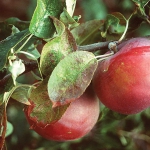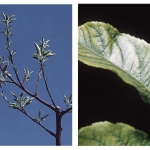Precise management of nutrients is an important part of precision horticulture, Dr. Gerry Neilsen, soil scientist with Agriculture and Agri-Food Canada in Summerland, British Columbia, Canada, tells growers.

Dr. Gerry Neilsen
“We’ve really got to start understanding the resources and sinks at a much more sophisticated level than we did before,” he said. He spoke during the International Fruit Tree Association’s annual meeting.
“We’ve got to match inputs to demand—there are a lot of environmental and economic advantages to that.”
Advantages include less risk of leaching nutrients in the ground as well as less wasted fertilizer from applying more than the tree needs or applying it at the wrong time.
Nitrogen was one of the first nutrients discovered to be important for tree growth. When growers applied it, there was an obvious growth response from the tree. It’s taken scientists much longer to understand the role of other nutrients in tree fruit production, Neilsen said, particularly those that are less mobile and are needed only in smaller quantities.
Phosphorus
It used to be thought that deficiencies of phosphorus were rare, but when Neilsen and his colleagues applied nitrogen and monoammonium phosphate as a replant treatment for apples, the trees grew better than those that received nitrogen alone. “We were quite shocked by that,” Neilsen said.
Following the lead of a Washington State grower, he also tested phosphorus fertigation at bloom in an established orchard with five cultivars and found it increased the cumulative yield. Evidently, the phosphorus went into the fruit, as it also had some quality effects on some varieties. For example, fruit from Silken trees that received high levels of phosphorus didn’t brown as easily when cut, possibly because it improved the stability of cell membranes, and fruit of Fuji and Silken had less watercore.
In cherry trials, phosphorus boosted yields in the first three years, improved fruit size, and increased the stem pull force, but it reduced soluble solids and seemed to delay maturity. It had a similar effect as a gibberellic acid treatment apart from the fruit not being as well colored, Neilsen said. Like GA-treated fruit, these cherries could be harvested later when color was darker and the fruit larger.
Potassium
It was once thought that Pacific Northwest soils were rich in this element because it was not being washed through the soil by rainfall, as occurs in the wetter eastern growing regions. However, it now appears that levels can be lower than suspected, perhaps because of irrigation.
Symptoms of a potassium deficiency include scorched edges of leaves, particularly in foliage near fruit, which itself is a strong sink for potassium. This can reduce photosynthesis, resulting in poor tree growth. In a trial with Fuji, Neilsen found it also resulted in poorly colored fruit.
Neilsen did a fertigation trial on a very sandy soil in which he made daily applications of soluble forms of potassium at various rates during the six weeks when the fruit was sizing (mid-July to mid-August).
He found that no matter which form of soluble potassium he used, leaf levels increased. Since then, in blocks where potassium was applied, he has run into a problem of declining magnesium because the two elements are antagonistic, and in a current cherry trial he’s thinking of switching to a potassium-magnesium (K-mag) treatment.
The ratio of potassium to calcium is also important, and one of the concerns about applying potassium is that it could negatively affect fruit quality. However, Neilsen said where soils are deficient in potassium, applications do not increase susceptibility of the fruit to bitter pit.
In another trial with Lapins cherries on Gisela 5, potassium was applied either through a drip system or microsprinklers. The trees irrigated with microsprinklers had a wider water distribution and higher potassium levels, which indicates that if the root volume is reduced too much in a sandy soil, it can limit potassium uptake, and that follows through to the fruit, Neilsen said.
Calcium
Calcium is the nutrient that most affects the postharvest quality of apples. Bitter pit is just one of many calcium-related disorders. Studies show that fruit calcium concentrations start out relatively high in the growing season, then drop, reaching their lowest level at harvest. However, fruit concentrations in the same orchard can fluctuate from one year to another, partly because the calcium concentration is related to fruit size. Larger fruit have lower concentrations.
Fruit with a high calcium concentration store well. Fruit with a high ratio of potassium to calcium does not, which is a reason not to fertigate with potassium unnecessarily.
Critical calcium levels vary by variety. For example, at six weeks before harvest, in British Columbia, the recommended fruit calcium level for McIntosh is 8.5 milligrams per 100 grams. For Golden Delicious, it’s 9.5 milligrams. At harvest, the recommended level for all varieties is 4 milligrams per 100 grams.
The standard recommendation for apples in British Columbia is to apply calcium spray four to five times at ten-day intervals starting mid-July at a rate of 8 to 12 kilos per hectare (7 to 11 pounds per acre). The idea was to target the fruit when it’s larger and has more surface area to absorb the calcium. However, for some cultivars, such as Braeburn and Honeycrisp, which are susceptible to calcium-related disorders, there are advantages to beginning applications in July, about four weeks after bloom, Neilsen said.
Boron
Sandy soils can become boron deficient, and in the 1930s, lack of boron almost wiped out the entire B.C. apple industry, Neilsen said. Trees developed blossom blast, a phenomenon where some of the blossoms are brown and fail to develop into fruit. Neilsen said it resembles frost damage except that it is erratic. It can also cause surface cracking of the fruit, known as droughtspot, which in the past was mistakenly attributed to water stress.
As boron is very mobile and soluble, fertigation is an effective way to boost levels in the tree, though when it’s overdone it can lead to boron toxicity, which manifests itself as shoot dieback. Trees don’t need much boron. Neilsen recommends a rate of 0.175 gram per tree annually, though different cultivars might have different requirements. Leaf analysis can provide a good measure of the tree’s boron status.
Zinc
Zinc typically is found in low levels in Pacific Northwest soils. Deficiencies can result in tiny leaves on some branches, rosetting (where the tree has a mixture of big and small leaves), and blind buds.
In Neilsen’s experience, fertigation is not effective in boosting zinc levels, but soil applications of zinc sulfate can be toxic. Zinc precipitates in the soil if the pH level is high, he said. “So we’re at the stage of using various dormant sprays and chelated zinc sprays,” he said. •








Leave A Comment